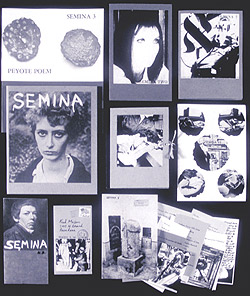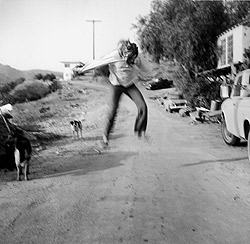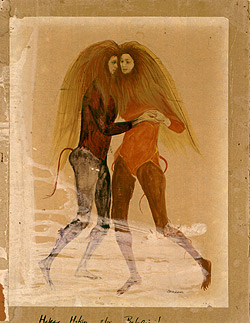Berkeleyan
 Wallace Berman's best-known works were collages combining enigmatic images from newspapers and magazines, such as Untitled (Engine, flowers, nun, pistol), above left. The collages were created with a Verifax machine, an early photocopier prototype. William Margolis, who made Untitled, the mixed-media piece at right, was a poet and co-editor of Beatitude, a quintessential publication of the Beat era. |
Loose-leaf legacy
Wallace Berman's Elvis-era journal disseminated bohemian art and poetry
![]()
| 18 October 2006
| More countercultural scenes at the museum |
Wallace Berman (1926-76) was a poet and artist, but as a new Berkeley Art Museum exhibit ("Semina Culture: Wallace Berman and His Circle") demonstrates, he was also a creative mentor to a group of mid-20th-century artists, poets, and writers known as the Beats. Between 1955 and 1964, Berman sporadically published nine issues of Semina, a free-form literary journal celebrating a freedom of expression that ran contrary to the staid, conservative atmosphere of the Eisenhower and Kennedy eras. A collection of works by the artists who surrounded Berman opens at BAM this week and runs through Dec. 10.
 "Semina's overarching theme involved a search for how to transcend the 'monster' of postwar meaninglessness," writes exhibit co-curator Michael Duncan about the magazine. |
A charismatic man of few words, Berman drew many young artists to his homes in Los Angeles and the Bay Area. Photographer Charles Brittin recalled the atmosphere at these "artistic dissemination center[s]" as one where people "came happily and sat down and left four hours later. . . .What happened is you'd listen to some music and smoke some pot and talk and look at things."
 Semina's publisher, Wallace Berman, in a self-portrait taken in 1974. |
The exhibit begins with pieces by Berman himself, an underrecognized artist whose images referenced French poetry, sports, jazz, and the Kaballah. The exhibit is organized around the diverse group of artists who were in Semina. Some were very well-known - such as DeFeo and Joan Brown - while others were not.
 Cameron, a member of Berman's circle and the creator of Hekas, Hskin Etoz Beahi 1, led a troubled life fraught with poverty and hardship. Her work, however, drew on the magical realm of metamorphosis and transformation. |
As BAM senior curator Constance Lewallen explains: "Some of these artists were primarily poets or performers who made art." Their visual artwork, she says, "was not commercial and had nothing to do with the art world. I would not say that everything here is a masterpiece - it's not. However, the show includes many wonderful works, and in experiencing its totality one gets a vivid sense of the spirit of that particular cultural moment."
--------------------------------------------
Semina contributors — poets Diane DiPrima, David Meltzer, and Michael McClure, and artist George Herms — will participate in a tribute to the journal's publisher on Sunday, Oct. 29, at 2 p.m. in the Berkeley Art Museum's Museum Theater. Exhibition co-curators Kristine McKenna and Michael Duncan will give a slide presentation illuminating works in the show. Also on hand will be Tosh Berman, the artist's son — who himself is a writer and publisher — with remembrances of his father.

